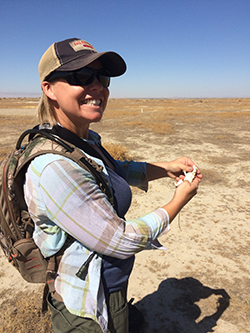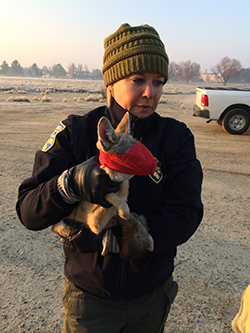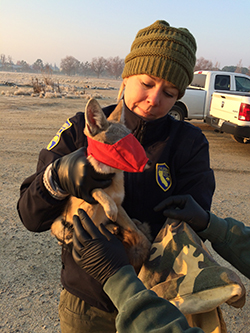
Mia holding a federally endangered blunt-nosed leopard lizard (Gambelia sila), helping environmental scientist counterparts from Region 4 with their annual population surveys in West Kern County.

Mia handling San Joaquin kit fox (Vulpes macrotis mutica) in Bakersfield.

In an effort to control a mange outbreak affecting the kit fox population in Bakersfield, Mia and other scientists were providing a helping hand to do some wellness checks for individual animals.
Mia Roberts is an environmental scientist for CDFW’s Office of Spill Prevention and Response (OSPR). She is part of the Fairfield-based field response team, tasked with responding to oil spills throughout the San Francisco Bay Area. She previously worked on the response team in Bakersfield.
Mia began her career with the department as a scientific aid working on the Delta Smelt and Coastal Pelagic Species programs. She then served a brief stint in the private sector, working as a scientist for an environmental consulting firm that specialized in electrical transmission projects. She returned to the department in her current role at OSPR about three years ago.
Mia earned a bachelor’s degree in integrative biology from the University of California, Berkeley, and has diverse professional experience in natural resources management and environmental compliance. She is also a fluent Spanish speaker after spending time studying abroad in Costa Rica.
Who or what inspired you to become a scientist?
My inspiration to pursue a career in natural resources protection came from my mother. She taught me to care for the environment around me, even if that meant picking up one piece of trash a day. She encouraged outdoor play, and many of our family outings were spent outdoors. In addition to my mother, Jane Goodall was (and still is) a powerful role model for me.
What got you interested in working with CDFW?
Not everyone is lucky enough to know what they want to “be” when they grow up, but I had a general idea of what I wanted to do since I was very young, which was to protect animals. My career goals evolved and matured over time as I accumulated professional and life experience, but my core interests have always stayed the same – speaking for the voiceless.
I have worked in private industry, the federal government and in non-profit organizations, but my favorite and most fulfilling work experiences have always been with CDFW. The work I have done, and continue to do, has always aligned with my childhood aspirations of protecting the natural world. I work alongside some amazing people at CDFW, and I have learned so much from them along the way. I hope to continue learning as much as possible with the department while simultaneously contributing to the protection of our state’s beautiful and unique natural resources for future generations.
What is a typical day like for you at work?
Being on the Northern Field Response Team means we are some of the first people on scene during an oil spill. My schedule could be full of oil spill drills, contingency planning and training activities, but it could all be dropped if the team has to respond to an oil spill. I love having a profession where I never know what my day is going to look like, because it keeps me on my toes and I never get bored.
I love working with a team to solve a problem, and being part of the response team provides endless opportunities to do that. Every spill we respond to is different and comes with its own challenges. Our main goal as the field response team is to safely clean up oil spills while causing the least environmental harm. I very much enjoy working with my fellow responders to accomplish that goal.
Over the course of your career, was there a discovery or an incident that surprised you?
My time with OSPR has been full of surprises, but the biggest one so far was learning about the history of oil in California. I had no idea that California played such a large role in oil production for the nation. Seeing the extensive Central California oil fields was a huge eye-opener, and it felt like I was on a whole new planet that I did not know existed. Here was black, sticky oil literally oozing out of the ground from natural seeps! The same seeps that created the tar-pit-death-traps for countless prehistoric creatures! How did I miss this my whole life?
If you had free reign and unlimited funding, what scientific project would you most like to take on?
I would love to train an oil detection dog to aid with oil spill response. Dogs are amazing creatures and can perform many tasks that could benefit the spill response community. Their capacity for scent detection and differentiation could really change the way we respond to oil spills in the state, and the department already has a wonderful infrastructure to support this type of project.
Do you have any advice for people considering careers in science or natural resources?
Get as much experience early on as you possibly can! The competition for entry-level natural resources and science jobs can be fierce, and oftentimes it is that little bit of volunteer time you had at that lab, or the summer you spent doing field work banding birds that can make all the difference.
The field of science is extremely broad, so I would recommend trying to identify the specific job you would like to do and spend your time gaining experience relevant to that position. During college, I spent a lot of my undergraduate time as a research assistant on various research projects, working for graduate students and research labs on campus. These jobs can provide you with the hands-on experience employers look for when hiring for entry-level positions.
###
CDFW Photos courtesy of Mia Roberts. Top Photo: Mia Roberts helping perform kangaroo rat surveys in West Kern County with our fellow environmental scientists from Region 4. The animal she is holding is a federally endangered giant kangaroo rat (Dipodomys ingens).